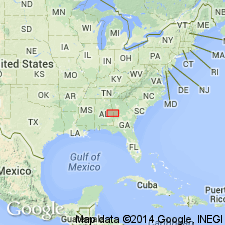
- Usage in publication:
-
- Smith Mountain ultramafic Complex
- Modifications:
-
- Named
- Dominant lithology:
-
- Pyroxenite
- Gabbro
- Norite
- Amphibolite
- Soapstone
- AAPG geologic province:
-
- Piedmont-Blue Ridge province
Summary:
Smith Mountain introduced as one of two large mafic-ultramafic complexes mapped in the Dadeville Complex. Rock assemblage includes enstatite-hypersthene-pyroxenite masses, metagabbro, metanorite, massive amphibolites, and soapstone. Massive hornblende-amphibolite has been found near Smith Mountain. Pyroxenite bodies range in diameter from a few inches to several hundred ft. Complex appears to underlie the Agricola Schist-gneiss, but contact relationships between the two have not been ascertained. Smith Mountain may represent an ancient volcanic plug.
Source: GNU records (USGS DDS-6; Reston GNULEX).
For more information, please contact Nancy Stamm, Geologic Names Committee Secretary.
Asterisk (*) indicates published by U.S. Geological Survey authors.
"No current usage" (†) implies that a name has been abandoned or has fallen into disuse. Former usage and, if known, replacement name given in parentheses ( ).
Slash (/) indicates name conflicts with nomenclatural guidelines (CSN, 1933; ACSN, 1961, 1970; NACSN, 1983, 2005, 2021). May be explained within brackets ([ ]).

